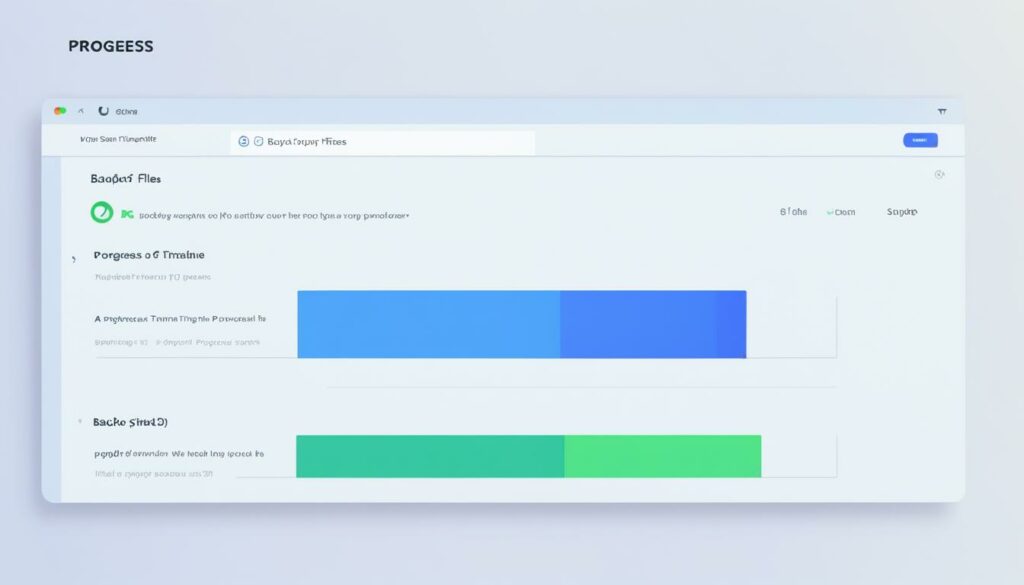Welcome to our guide on website migration! If you’re considering a website transfer, redesign, or even a domain migration, it’s essential to plan carefully to ensure a smooth transition with minimal downtime. In this article, we’ll walk you through the website migration process, providing you with valuable tips, best practices, and strategies to overcome potential challenges. Let’s get started!
Key Takeaways:
- Website migration can be challenging but with the right strategies, you can minimize downtime during the process.
- Reasons for website migration can include seeking better website hosting features and functionality.
- Before canceling your existing plan, ensure you have selected a new hosting provider and transferred all your files.
- Downloading backup files is crucial to ensure a smooth migration.
- Perform a thorough transfer of your website files and databases to the new server.
Reasons for Website Migration
Are you considering migrating your website to a new hosting provider? There can be several compelling reasons to make the move. Let’s explore some of the key factors that may prompt you to embark on this journey.
- Website Hosting Features: Your current hosting provider might not offer all the features you need to enhance your website’s performance and functionality. Whether it’s better storage options, improved security measures, or advanced developer tools, migrating to a new hosting provider can give you access to the features you desire.
- Minimal Downtime: While website migration can be a complex task, minimizing downtime is crucial to ensure your website remains accessible to your audience. Choosing a new hosting provider that specializes in smooth migrations and provides efficient transfer processes can help you avoid lengthy periods of website unavailability.
By carefully considering these factors and understanding your unique requirements, you can make an informed decision about migrating your website to a new hosting provider.
BoostedHost WordPress Hosting – The Optimal Choice
“At BoostedHost, we prioritize seamless website migration and minimal downtime for all our clients. Our WordPress Hosting plan is designed to deliver exceptional performance and a smooth transition experience. Join the thousands of satisfied customers who have migrated their WordPress websites to BoostedHost for unmatched reliability and top-notch features.”
Sign up now for BoostedHost WordPress Hosting and enjoy the benefits of a trusted hosting platform. Don’t miss out on this opportunity to elevate your website’s performance and ensure a successful migration.
| Features | BoostedHost WordPress Hosting |
|---|---|
| Automatic WordPress Updates | Yes |
| 24/7 Expert Support | Yes |
| Enhanced Security Measures | Yes |
| Advanced Caching Technology | Yes |
| One-Click WordPress Installation | Yes |
Preparing for Migration: First Move Then Cancel
Before you kickstart the website migration process, it’s essential to have a solid plan in place. One crucial step to remember is not to cancel your existing hosting plan until the migration is complete. Cancelling your plan too early could result in the loss of important files and vital database information. So, what should you do instead?
First, ensure that you have selected a new hosting provider and prepared everything for the migration. Once you have migrated all your files and databases to the new hosting environment, it’s time to run your website on the new server for a few days. This will give you an opportunity to verify that everything is functioning smoothly and properly before cutting ties with the old hosting plan.
Only when you are confident that the migration was successful and that your website is functioning seamlessly on the new server should you proceed to cancel your old plan. This ensures that you have a backup plan in place and minimizes any potential disruptions to your website’s availability and performance.
Remember, the key is to move first and then cancel. Don’t rush to cancel your old hosting plan before you’re absolutely certain that the migration has been completed successfully.
Website Migration Checklist
| Steps | Status |
|---|---|
| Select a new hosting provider | ✓ |
| Transfer all website files and databases to the new server | ✓ |
| Run your website on the new server for a few days to ensure everything is functioning correctly | ✓ |
| Cancel the old hosting plan | In Progress |
By following this approach, you can minimize the risk of any potential data loss or disruption to your website’s performance during the migration process. Take the necessary precautions, and remember to double-check that everything is in order before making the final move.
Downloading Backup Files
To ensure a smooth migration, you need to download backup files of your website files and database information. Follow these steps to download and secure your backups:
- Log in to your cPanel account.
- Locate the backup tools in the cPanel interface.
- Click on the backup tools to access the available options.
- Depending on your hosting provider, you may find different backup options. Look for the options to download the compressed backups of your website’s files and databases.
- Click on the respective backup options to initiate the download.
- Save the backup files to a secure location on your local device or cloud storage.
It’s important to remember that both your old and new hosting providers should be using the same web-based technologies, such as cPanel or PleskPanel, for easier backup and restoration.
Here is an example of what your backup file structure might look like:
| Backup Files | Description |
|---|---|
| website_files.zip | A compressed file containing all your website’s files, including HTML, CSS, images, and other media. |
| database.sql | A SQL file containing the database information, including tables, records, and configurations. |
Once you have downloaded the backup files, you can proceed to the next section to perform the transfer and complete the migration process.
Performing the Transfer
Once you have the backup files, it’s time to upload them to your new server. To get started, you’ll need the following details provided by your new hosting company:
- IP address
- FTP account credentials
- cPanel admin interface login information
Using these details, you can log in to your new server’s cPanel and navigate to the backup tools section. Here, you can initiate the upload process to transfer all your files and databases.
Make sure you follow these steps:
- Access your new server’s cPanel admin interface using the provided login credentials.
- Navigate to the backup tools section.
- Locate the option to upload files and databases.
- Choose the backup files you downloaded earlier.
- Initiate the upload process and wait for it to complete.
By carefully following these steps, you can ensure a successful transfer of your backup files to the new server.
| Step | Instructions |
|---|---|
| 1 | Access your new server’s cPanel admin interface using the provided login credentials. |
| 2 | Navigate to the backup tools section. |
| 3 | Locate the option to upload files and databases. |
| 4 | Choose the backup files you downloaded earlier. |
| 5 | Initiate the upload process and wait for it to complete. |

Ensuring Database Functionality
Your website’s database is a crucial component of your online presence. When migrating your website to a new server, it’s important to ensure that your database functions smoothly. Here are some steps to take to ensure the seamless operation of your database after the migration process.
- Check your database backup files: Before starting the migration, make sure you have backup files for your database. These backup files may not include usernames, passwords, and permissions, so you’ll need to enter this information manually in the database interface within cPanel.
- Pay attention to prefixes: Your database may have prefixes assigned to it, such as “wp_” for WordPress databases. It’s essential to check that these prefixes match the configuration file of any software applications connected to the database.
- Add relevant information: Once you’ve accessed the database interface within cPanel, enter the necessary usernames, passwords, and permissions for your database. This information is crucial for ensuring that your website functions correctly after the migration.
- Modify settings: In some cases, you may need to modify certain settings in the database interface to ensure compatibility with the new server. Make any necessary adjustments to optimize the functionality of your database.
| Keywords | Explanation |
|---|---|
| Database backup files | Backup files containing your database information. |
| Usernames | Unique identifiers for accessing and managing your database. |
| Passwords | Secure credentials required to log in to your database. |
| Permissions | Access rights that determine what actions can be performed on the database. |
| Database interface | A user-friendly platform for managing and interacting with your database. |
| Prefixes | Short codes added to database tables to differentiate them from other data. |
By following these steps, you can ensure that your database functions optimally on the new server, maintaining the seamless operation of your website.
Changing Nameservers
To complete the migration process, you need to inform your domain registrar about the change in nameservers. This is done through the domain registration control panel provided by your registrar. Look for the “Domain Name Servers” section and replace the old nameservers with the new ones provided by your new hosting provider. Changes to the DNS records may take some time to propagate, so it’s important to wait until this process is complete before making any further changes to your site.

| Steps for Changing Nameservers |
|---|
| Step 1: Log in to your domain registrar’s control panel. |
| Step 2: Locate the “Domain Name Servers” section. |
| Step 3: Replace the old nameservers with the new ones provided by your new hosting provider. |
| Step 4: Save the changes and wait for DNS propagation to complete. |
Migration for Different Types of Websites
When it comes to website migration, different types of websites require different processes to ensure a successful transition. Whether you have a static website, a WordPress site, a Magento store, or a cross-platform site, understanding the specific requirements of your website type is crucial for a seamless migration.
Static Websites
For static websites, migrating the files to a new host is relatively simple. You can download the website files from your current hosting provider and upload them to the new server. It’s important to ensure that all the file paths remain consistent to maintain the site’s functionality. Once the files are transferred, make sure to test the site on the new server to confirm that everything is working correctly.
WordPress Migration
Migrating a WordPress website can be done using plugins or manually following a multi-step process. WordPress offers several migration plugins that simplify the process, allowing you to export your site’s content, themes, plugins, and database directly to the new host. Alternatively, you can perform a manual migration by downloading the files, exporting the database, setting up a new WordPress installation, and importing your content and settings. Make sure to update the website’s URLs and perform thorough testing after the migration is complete.
Magento Migration
If you have a Magento store, the migration process is similar to that of a WordPress site with some modifications. You’ll need to download the Magento files and database from the current server and then upload them to the new hosting provider. Additionally, you might need to update the configuration files and modify the database settings to ensure compatibility with the new server. As with any migration, thorough testing is essential to ensure that the store functions correctly after the transfer.
Cross-Platform Site Migration
Cross-platform site migrations involve moving a website from one platform to another, such as from a Windows-based Plesk host to a Linux-based cPanel host. In these cases, manual transfer or content copying is often required since the underlying technologies and configurations may differ significantly. It’s important to carefully analyze and map out the requirements of both platforms to ensure a successful migration. Plan each step carefully, transfer the necessary files and databases, and test the site thoroughly after migration to address any potential issues.
Remember, regardless of your website type, having a comprehensive backup and contingency plan is crucial before starting any migration process. This ensures that you can restore your site in case anything goes wrong during the transfer.
| Website Type | Migration Process |
|---|---|
| Static Websites | Download files from old host. Upload files to new host. Test site on new server. |
| WordPress | Use migration plugins or manually export/import files and database. Update URLs and perform testing. |
| Magento | Download files and database. Upload to new host. Update configuration and database settings. Test thoroughly. |
| Cross-Platform | Manual transfer or content copying. Analyze and map out requirements of both platforms. Test extensively after migration. |
Regardless of the type of website you have, ensure that you have a clear understanding of the migration process, follow best practices, and work with a reliable web hosting provider to minimize any potential downtime and ensure a successful migration.
Backup and Contingency Planning
Before starting the migration process, it is crucial to prioritize backup and contingency planning. By proactively creating backups of your website files and databases, you can mitigate the risk of data loss and ensure a smooth transition. Here are some essential steps to consider:
- Regularly back up: It is important to regularly back up your website files and databases to ensure you have the latest versions. This ensures that if anything goes wrong during the migration process, you can easily restore your site to its previous state.
- Test the restoration process: Simply having backups is not enough. It is equally important to test the restoration process to ensure that everything functions as expected. This will give you confidence in your backup strategy and ensure that you can quickly restore your site if needed.
- Create a contingency plan: While careful planning minimizes the chances of issues arising during migration, it is always wise to have a contingency plan in place. Consider having a backup server or a temporary maintenance page ready to display to visitors in case any unforeseen issues occur during the migration process.
Creating website backups and having a contingency plan not only protects your valuable data but also gives you peace of mind during the migration process. Take the necessary precautions, and you’ll be well-prepared for a successful migration.

BoostedHost offers reliable and secure WordPress Hosting services for optimal performance. Sign up now through this link to ensure a smooth and hassle-free migration experience.
Considerations for Platform-Specific Migrations
When it comes to platform-specific migrations, such as moving from a Windows-based Plesk host to a Linux-based cPanel host, there are some additional factors to consider. These types of migrations can be more complex and may require manual transfer of your website data. To ensure a smooth transition, it’s essential to communicate with your new hosting provider and discuss your specific requirements and any challenges you may face during the migration process.
Platform-specific migrations often involve different server configurations, file systems, and database management systems. This means that your existing website may need adjustments to work seamlessly on the new platform. It’s crucial to evaluate your website’s compatibility with the new platform and understand any potential limitations or differences in functionality.
Choosing the Right Web Hosting Provider
When planning a platform-specific migration, it’s important to select a web hosting provider that specializes in the platform you’re migrating to. For example, if you are migrating to a Linux-based cPanel host, consider a hosting provider like BoostedHost that offers optimized WordPress Hosting tailored specifically for the Linux environment.
BoostedHost’s WordPress Hosting provides a reliable and high-performance solution for WordPress migrations to Linux-based platforms. By leveraging their expertise in WordPress hosting, you can ensure a smoother transition and take advantage of the optimized performance and security features offered by BoostedHost.
Sign up now for BoostedHost’s WordPress Hosting through this link and experience the benefits of a platform-specific migration!
Expert Support and Assistance
Platform-specific migrations can pose unique challenges, but with expert support and assistance, you can navigate through the process smoothly. Collaborate with your new hosting provider to address any technical hurdles, ensure proper configuration, and optimize your website’s performance on the new platform.
“Migrating from one hosting platform to another can be daunting, especially when you are moving from a Windows-based Plesk host to a Linux-based cPanel host. However, with the right guidance and support from your hosting provider, you can successfully navigate through the complexities of platform-specific migration and achieve a seamless transition.” – Amy Johnson, Web Hosting Specialist at BoostedHost
During the migration process, maintain open lines of communication with your new hosting provider. They can provide guidance, offer solutions, and address any unforeseen issues that may arise. With their expertise, you can ensure a smoother transition and minimize any potential downtime or disruptions to your website.
Testing and Verification
After completing the migration, thorough testing and verification are essential to ensure that your website functions properly on the new platform. Test all aspects of your website, including its design, functionality, and compatibility with plugins or extensions.
It’s also crucial to conduct thorough testing of your website’s database integration, ensuring that all data is transferred correctly and that database-driven features or functionalities work as expected. This includes verifying usernames, passwords, permissions, and any necessary configurations.
Continued Optimization and Maintenance
Following a platform-specific migration, ongoing optimization and maintenance are crucial for the long-term success of your website. Regularly monitor your website’s performance, security, and compatibility with the new platform. Stay up to date with software updates, security patches, and best practices specific to the platform you’ve migrated to.
By providing continuous attention and maintenance, you can ensure that your website operates optimally and takes advantage of the benefits offered by the new hosting platform.
To summarize, platform-specific migrations require careful consideration and preparation. Partnering with a specialized hosting provider like BoostedHost, open communication, expert support, thorough testing, and ongoing optimization will contribute to a successful migration that allows your website to thrive on its new platform.
Conclusion
Website migration can be a daunting task, but with careful planning and adherence to best practices, you can achieve a seamless transition with minimal downtime. By following the strategies outlined in this article and working with a trusted web hosting provider, you can ensure a successful website migration that preserves your digital presence and minimizes disruptions for your visitors and customers.
Remember to prepare for the migration by first moving your files and transferring them to the new server. Don’t cancel your existing hosting plan until the migration is complete to avoid any data loss. Download backup files and ensure their successful transfer to the new server. Verify the functionality of your databases and make any necessary modifications.
Changing nameservers is an essential step in completing the migration process. Update the nameservers in your domain registrar’s control panel to point to the new hosting provider. Keep in mind that DNS propagation may take some time, so be patient before making any further changes.
Website migration success relies on meticulous planning, careful execution, and working with a reliable web hosting provider. To ensure optimal performance, we recommend BoostedHost’s WordPress Hosting. Sign up now through this link to experience seamless migration with minimal downtime.
FAQ
Q: Why would I consider migrating my website to a new hosting provider?
A: One common reason is that your current provider may not offer all the desired features you need.
Q: How can I minimize downtime during the website migration process?
A: Carefully planning the migration process is crucial to avoid disrupting your website’s availability and functionality.
Q: What should I do before starting the migration process?
A: It’s crucial not to cancel your existing hosting plan until the migration is complete. Make sure you have selected a new hosting plan and transferred all your files before canceling the old one.
Q: How do I download backup files of my website?
A: In cPanel, locate the backup tools and download the compressed backups of your website’s files and databases.
Q: How do I perform the transfer of my website files?
A: Use the provided IP address and details to access the FTP account and cPanel admin interface on the new server. Upload the backup files to the new server through cPanel.
Q: What do I need to do to ensure the functionality of my database?
A: Enter necessary information, such as usernames, passwords, and permissions, into the database interface within cPanel. Pay attention to the prefixes assigned to each database and ensure they match the configuration file of connected software applications.
Q: How do I change the nameservers for my domain?
A: Inform your domain registrar about the change in nameservers through the domain registration control panel. Replace the old nameservers with the new ones provided by your new hosting provider.
Q: What are the migration considerations for different types of websites?
A: Static websites can be moved by transferring the files. WordPress and Magento websites may require specific migration processes. Cross-platform site migrations may involve manual transfer or content copying.
Q: Why is backup and contingency planning important?
A: Creating backups and testing the restoration process ensures that you can recover your website in case anything goes wrong during the migration. Having a contingency plan helps address any unforeseen issues that may arise.
Q: What should I consider when migrating between different hosting platforms?
A: Platform-specific migrations may require additional considerations and support from your new web host. It’s important to communicate with your hosting provider and discuss your specific requirements and challenges.
Q: How can I achieve a successful website migration with minimal downtime?
A: By following the strategies outlined in this article and working with a trusted web hosting provider, you can ensure a seamless transition that preserves your digital presence and minimizes disruptions for your visitors and customers.












